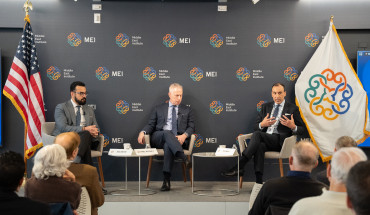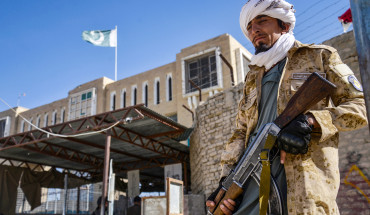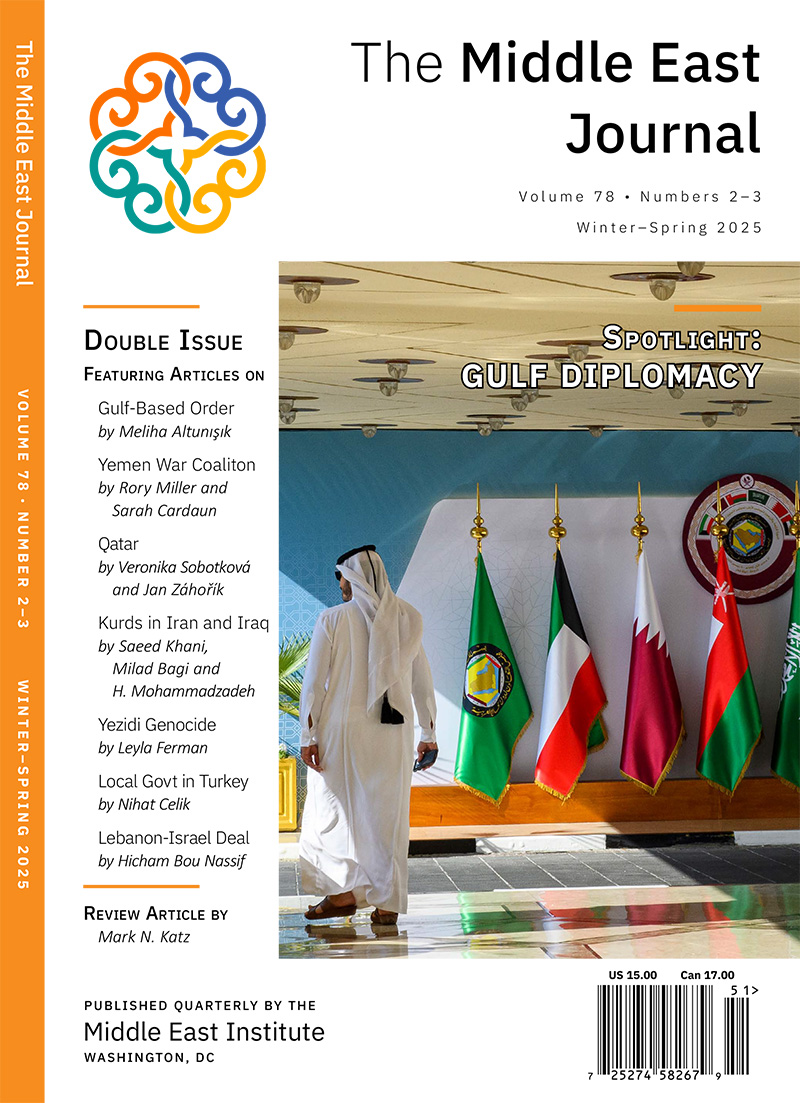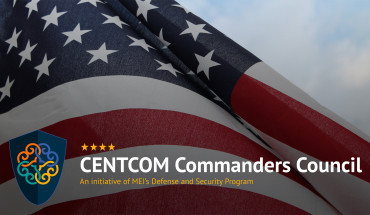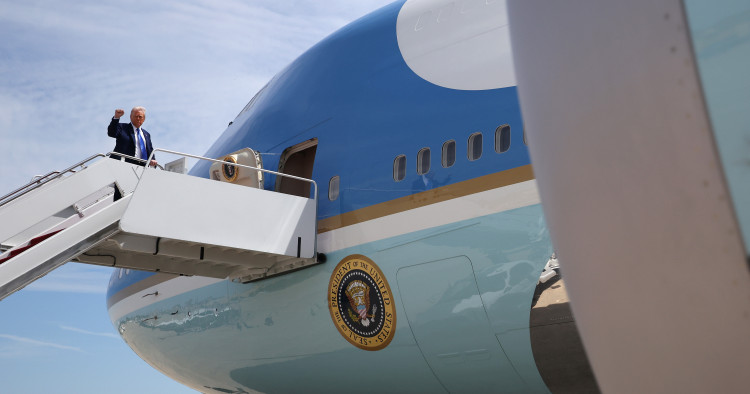This week, US President Donald Trump makes his inaugural visit to the Middle East since the start of his second term, traveling to Saudi Arabia, Qatar, and the United Arab Emirates on May 13-16. Amid the heightened focus on US policy toward the Middle East, MEI’s experts take stock of Trump’s trip to the Gulf, how his administration has shaped its approach to the wider region in its first several months, and how regional actors are responding to the policies coming out of Washington.
Contents:
- Assessing Trump’s record and potential impact in the Middle East
- Gulf countries are well placed to navigate the policy swings of the second Trump administration
- President Trump’s upcoming visit to the Gulf: Transactionalism over diplomacy
- Points of contention, some areas for cooperation in US-Saudi energy and economic ties
- Americans skeptical about Trump’s foreign policy approach on the eve of Middle East trip
- Iran wants a deal with Trump. It just has not decided how big
- Is Iran facing a Vietnam moment?
- A ceasefire isn’t enough: What Trump must do next on the Houthis
- The dramatic ups and downs for Egypt of Trump’s first 100 days
- US has fallen behind the region when it comes to seizing the opportunity in post-Assad Syria
- Ankara continues to see Trump’s return as an opening
- How US-Gulf coordination can secure Lebanon and reshape the Levant’s future
- Trump’s footprint in North Africa: Transactional diplomacy or enduring impact?
- In Libya, a US reset amid regional realignments
- Afghanistan and Pakistan have commanded little time and interest from Washington. Could that now change?
- Trump’s first visit abroad is to a region increasingly dominated by great power competition
Assessing Trump’s record and potential impact in the Middle East
Paul Salem
Vice President for International Engagement

-
To date, President Donald Trump’s Middle East policy has been marked by moments of clear impact but also lingering ambiguity and unfulfilled ambitions.
-
If he can employ his and the US’s significant leverage in the region, Trump could bring about real transformative change, including a Saudi-Israel normalization deal, a new framework with Iran, deeper US-Gulf tech partnerships, and diplomatic breakthroughs in Lebanon, Syria, and Israel-Palestine.
A little over a hundred days into Donald Trump’s second term, and just ahead of his trip to Saudi Arabia, Qatar, and the United Arab Emirates, the US president’s Middle East policy remains a work in progress.
Interestingly, Trump had clear impact on several key regional issues even before he took office. His insistence that he wanted wars to be over spurred the Israeli government to conclude cease-fire agreements with both Hamas and Hezbollah prior to Trump’s inauguration day. He might be able to again significantly influence developments in the Middle East after he devotes more time there in his coming visit and clarifies his positions and actions. So far, however, the record has been mixed.
On Gaza, Israel concluded a cease-fire agreement with Hamas just hours before Trump took office. And the US administration devoted a lot of attention in its early weeks to move the Israeli-Hamas negotiations forward. But since then, the originally agreed cease-fire period has run out and the talks have broken down. Last week, Israel announced it is preparing a large-scale military operation there, leading to at least a partial long-term occupation, even as the dire humanitarian situation grows steadily worse amid Israel’s ongoing blockade on aid. After announcing his short-lived “Riviera” plan for Gaza earlier this year, Trump has appeared to lose interest in mediation there, sent his main envoy Steve Witkoff to focus on Russia and Iran, and echoed the Israeli position that if Hamas does not hand over all hostages, he would let all “hell break loose.” Whether these positions will be affected by Trump’s meetings in the three Arab Gulf capitals is yet to be seen.
On the West Bank — where the situation has also dramatically worsened — Trump promised he would make an announcement two months ago; but no major administration position there has emerged. It is no secret that one of Trump’s main goals in the Middle East is to cement a historic tripartite agreement between the United States, Saudi Arabia, and Israel. This will not be possible — on the Saudi side — without a stop to the war in Gaza and some concessions to the Palestinians, even if minor, on the West Bank. Israeli Prime Minister Benjamin Netanyahu is not in a position to deliver any of that, and it is not clear how Trump will handle or confront this challenge. But if the US leader succeeds in achieving the breakthrough normalization between Saudi Arabia and Israel, that would be transformative for the region.
On Iran, Trump has moved swiftly to reimpose maximum pressure and to engage in high-level negotiations. Here too, his goal is potentially transformative: to strike a lasting agreement with Tehran that will take the latter’s nuclear weapons option off the table, reduce the risk of major regional war, and encourage Iran to build on its normalized relations with the Gulf Cooperation Council (GCC) members by engaging with other regional countries not through proxy militias but through more normal state-to-state relations. So far, the US-Iranian talks are in very preliminary stages. How they play out could lead to a transformative deal, or a collapse of diplomacy and slide to war.
Meanwhile, the administration’s main forward-looking focus is to greatly deepen America’s ties with its Gulf partners by going beyond the old oil-for-security relationship toward a 21st century partnership encompassing technology and artificial intelligence development (AI). To compete with China in these future fields, the US would strongly benefit from the financial and energy resources of the Gulf. This new tech and AI partnership spans both the public and private sectors, got started during the previous administration of President Joe Biden, and will almost certainly see new strides forward during Trump’s visit to the Gulf.
On Yemen, Trump has scored a win: After enduring weeks of bombing, the Houthis have pledged to halt their attacks, at least on US vessels in the region. Whether this will extend to other Red Sea shipping is yet to be seen. It does not extend to Israel — the Houthis claim they intend to shut down the Israel’s airspace by targeting its airports — but Israel is organizing its own military campaign against the Yemeni group.
On Syria, Trump has yet to truly focus on that issue. He will hear a lot about it during his Gulf visit. Doubts about the new regime in Syria abound and are warranted, but a focused engagement, with potent use of both positive and negative leverage, could push the new leadership in Damascus to move in the right direction. That would be transformative, not only for Syria, but also for Lebanon and the broader Levant.
Success in Syria will also depend on Trump’s other upcoming engagement in the region, that with Turkish President Recep Tayyip Erdoğan. The two leaders had a recent phone call, and Trump invited Erdoğan to the White House. The US president can play a major role in defusing potential Israeli-Turkish tensions, avoiding a Turkish-Kurdish conflict, as well as seeing Syria move toward a more peaceful and economically integrated future in the region.
Finally, on Lebanon, US policy has seen considerable success. The Israeli-Hezbollah cease-fire agreement negotiated last November is largely holding, and the US heads a military committee that oversees the deployment of the Lebanese army to replace Hezbollah in the south. Trump can help complete the process by persuading Israel to withdraw from the remaining five points it occupies in southern Lebanon as well as pressing the Lebanese authorities to consolidate their sovereignty by disarming both Hezbollah and the armed Palestinian factions in the country.
Sadly, the ongoing civil war and humanitarian disaster in Sudan is getting none of the administration’s attention.
Trump’s Middle East policy, now entering a more active phase with his upcoming Gulf tour, is still a work in progress. To date, it has been marked by moments of clear impact but also by lingering ambiguity and unfulfilled ambitions. The potential for transformation is real: a Saudi-Israel normalization deal, a new framework with Iran, deeper US-Gulf tech partnerships, and diplomatic breakthroughs in Lebanon, Syria, and Israel-Palestine. But these outcomes depend on whether Trump can employ his and the US’s considerable leverage to achieve key goals, all the while balancing competing priorities across a fractured region. His next steps may well determine whether his second term leaves a lasting legacy in the Middle East or merely another chapter of missed opportunities.
Follow: @paul_salem
Gulf countries are well placed to navigate the policy swings of the second Trump administration
Daniel Benaim
Associate Fellow

-
The Trump administration’s warm approach to the Gulf stands in sharp contrast to other US alliances and overseas commitments.
-
Gulf states are used to navigating swings in US policy and economically see an upside to Donald Trump’s visit, assuming there are sustained policy initiatives and rigorous follow-through; key opportunities will include streamlined foreign direct investment in the US and cooperation in artificial intelligence.
President Donald Trump’s decision to make the Arabian Peninsula his first planned international destination of his second term underscores that these are US partners he most wants to deal with. This follows a string of high diplomacy hosted in the Gulf: Gaza talks in Doha, Russian-Ukrainian talks in Riyadh, and nuclear talks with Iran in Muscat. The administration’s warm approach to the Gulf stands in sharp contrast to other US alliances and overseas commitments.
The decision to visit the United Arab Emirates and Qatar as well as Saudi Arabia is a welcome sign. Sometimes Washington underrates the value of a balanced set of Gulf partnerships — each Arabian Peninsula state offers a different mix of strengths, shortcomings, and priorities to advance US interests.
While the administration aimed to showcase diplomatic progress on the trip, the situation remains unsettled. Talks with Iran have moved ahead, though there is a gap between rhetoric and reality. An intensive bombing campaign led to a separate bilateral understanding with the Houthis. In Gaza, a Trump-backed cease-fire collapsed into renewed fighting. And hopes for Israel-Saudi normalization have receded for now.
Gulf states are well-practiced at navigating swings in US policy. Officials privately express bewilderment and concern at America’s shifting and uncertain role in the world — but remain among the best positioned US partners to navigate the uncertainty,
On the economic front, Gulf states see opportunity in this trip. There will be heavily marketed investment announcements and commercial deals. But durable gains depend on rigorous follow-through and sustained policy initiatives. One such initiative is streamlining Gulf investment into the US. Foreign direct investment rightly faces significant national security scrutiny. Yet reforms could make the review process clearer, faster, and more reliable without undermining safeguards. A recent Trump White House executive order set this process into motion. If implemented with care, that could benefit American workers and Gulf investors alike.
Artificial intelligence (AI) presents another area for deepening cooperation. Gulf firms are purchasing advanced US semiconductors, investing in AI infrastructure, and accepting in principle tight security safeguards to maintain their place in America’s tech ecosystem and prevent leakage to China. They are also preparing to fund capital-intensive US-based AI efforts.
Ahead of the trip, the Department of Commerce has announced it will rescind a Biden administration rule governing the export of advanced US semiconductors. Many questions remain as to what will replace it, along with what will be required of Gulf states, in what format, and how much computing power will be offered to them in return. These changes merit watching closely. While big purchases get headlines, tech cooperation, done responsibly, could reshape long-term ties.
Gulf governments are well equipped to engage on transactional terms. However, recurring concerns over high-profile personal economic conflicts of interest will undercut public confidence even when cooperation serves US interests.
Finally, while many Gulf governments and their citizens will welcome US recognition of the region’s place on the global stage, people-to-people ties are fraying. Gaza remains a visceral issue. Even Gulf families with longstanding ties to the United States are expressing unease about coming to study, seek medical care, or otherwise visit the country amid unpredictable and aggressive new immigration policies. These links have been a quiet foundation of US influence and deserve careful tending.
President Trump’s upcoming visit to the Gulf: Transactionalism over diplomacy
F. Gregory Gause, III
Visiting Scholar

-
When it comes to conventional diplomatic issues, including talks with Iran, the Gaza war, and oil price cuts, President Donald Trump and Gulf leaders have few serious bones of contention.
-
But the Gulf states worry that Trump’s tariff, trade, and investment policies, which curtail global economic activities, jeopardize their ambitious development projects; and they can do little beyond offering investment promises and trade deals in the hopes of securing exemptions.
President Donald Trump is visiting Saudi Arabia, Qatar, and the United Arab Emirates on his first overseas trip of his second term for the same reason that Willie Sutton robbed banks — because that is where the money is. This most transactional of presidents is looking for transactions he can highlight as bringing money and jobs to the United States, through arms deals and promises of Gulf investment in the American economy. He is also, indirectly but clearly, putting his imprimatur on real estate and investment deals that his sons, who are in charge of his businesses, have been making with partners in these countries.
There are certainly more conventional diplomatic issues on the US president’s upcoming agenda with Gulf leaders but no real bones of contention. The Gulf states are supportive of his diplomatic outreach to Iran, fearful that an Iranian-American confrontation would spill over on them and be bad for business. They are not happy with the renewed Israeli offensive in Gaza, but that is not high on their priority list, nor, it seems, on President Trump’s. The hopes both the Trump and Biden administrations had for progress on Saudi-Israeli normalization are on hold while Gaza burns. Saudi Arabia has already committed to an increase in oil production, which is driving down prices on global markets. That decision was probably motivated more by a desire to punish members of OPEC+ like Iraq, Kazakhstan, and the UAE, which are exceeding their production quotas; but it will be sold to Trump as a response to his vocal desire for lower gasoline prices at the pump.
The biggest problem Gulf leaders currently have with their US counterpart — Trump’s influence on the international economy — will not appear on the agenda. The Gulf countries’ ambitious economic transformation projects, particularly Saudi Arabia’s Vision 2030, the signature initiative of Saudi Crown Prince Mohammad bin Salman (MBS), are predicated on a globalized world economy open to trade and investment. But to the extent the Trump administration’s policies on tariffs, trade, and investment constrict global economic activity, the Gulf states’ long-term futures are imperiled. Their immediate fortunes are dependent on oil prices, which slower global economic growth will depress. Their currencies are pegged to the dollar, which is losing value as a result of Trump’s policies. The Gulf leaders have little leverage over President Trump when it comes to his signature economic initiatives. Therefore, the most they can do, as other world leaders and industry titans have done, is offer specific promises, like arms sales and investments, for specific exemptions from Trump economic policies that harm them most directly.
Points of contention, some areas for cooperation in US-Saudi energy and economic ties
Karen E. Young
Senior Fellow, Economics and Energy Initiative

-
Although Saudi and US oil policies diverge, the two countries could reach a deal during President Donald Trump’s upcoming visit to the kingdom.
-
If Trump shows willingness to consider incentives for US direct investment in Saudi Arabia, it could engender some synergy and dealmaking around the visit; whereas his original ask for $1 trillion of Saudi investment in the US is less likely to be answered because of the kingdom’s twin deficits and Saudi business retrenchment concerns.
Saudi Arabia and the United States are currently not aligned on oil policy. US President Donald Trump wants lower oil prices, which is indeed happening but as a result of his trade policies that are hampering oil demand outlook in Asia and threatening global growth. For Saudi Arabia, the downturn in the oil price happened to coincide with pre-planned curtailed cuts by the OPEC+ producer group, comprising the 12 members of the Organization of the Petroleum Exporting Countries (OPEC) and 10 other non-OPEC producers. Saudi Arabia has borne the lion’s share of OPEC+ production cuts since 2022. Therefore, the group decided on April 3, in tandem with Trump’s tariff announcements the previous day, to begin unwinding cuts and increasing group output, including for Saudi Arabia. The group met again on May 3 and decided to increase production further. The move signals at least three important facts: that there is less patience inside OPEC+ for withholding barrels, certainly less patience for those group members that had been overproducing from their quotas, and that Saudi Arabia would like to maintain and protect some of its market share. It could also signify that Saudi Arabia and OPEC+ may be attempting a repeat move against US shale production, which is less economical as oil nears and drops below $60 per barrel. US production is expected to falter and, again, the fight for market share will be more advantageous to Gulf oil exporters, given their lower production costs and closer client relationships with Asian buyers.
Meanwhile, the American president is likely to repeat his request for Saudi investment in the United States when he visits Riyadh, akin to his previous over-the-top ask of a $1 trillion commitment. That number was never realistic, but with Saudi Arabia’s twin current account and fiscal deficit, it is pure wishful thinking given the domestic priorities the kingdom faces in its spending requirements and the increasing need for foreign currency from export receipts. Declining oil revenues deepen this shortfall. The deal to be made, then, is one that offers some foreign direct investment incentives in Saudi Arabia for US companies to operate and generate in-kingdom added value — this could also be seen as an opportunity for US exports in computing and technology, nuclear energy know-how and components, mining, and other non-oil sectors like tourism.
One of the longer-term effects of the trade war and US imposition of tariffs on all trade partners will be higher interest rates and capital costs, especially in capital-intensive project finance across the energy sector globally, in both oil and natural gas as well as renewable energy. The higher yield on US Treasuries for longer-term bonds indicates that investors see neither inflation easing nor a reprieve in US interest rates, and this is passed on to other markets, especially those with fixed monetary policies like the Gulf Cooperation Council (GCC) states. For Saudi businesses, the immediate concern will be a retrenchment and shift in government contract award cycles, a slowdown or cancelation of awards, and shifts in bank lending or cost of capital. The government’s twin deficits, in both the fiscal account (how it can spend) and current account (how imports are exceeding exports), mean there is an immediate need for fresh incoming dollars — if that cannot be met with increasing export receipts, it needs to be met with the sale of assets domestically. If President Trump shows any willingness to encourage US investors to “buy Saudi, make it American,” it could engender some synergy and dealmaking around the visit; but it is difficult to see how his administration centers the needs of partners within its current “America First” ideology.
Follow: @ProfessorKaren
Americans skeptical about Trump’s foreign policy approach on the eve of Middle East trip
Brian Katulis
Senior Fellow

-
Support for Donald Trump’s overall foreign policy approach is weak, with a majority of Americans disapproving of how he is handling international affairs; while Middle East issues themselves are low on the list of priorities in domestic political debates.
-
It is still early in his second term, but the lack of a signature achievement in Trump’s foreign policy after many grandiose promises hangs over his trip to the Gulf.
President Donald Trump’s overall political standing in the United States has dropped in recent weeks, largely as a result of his unpopular tariffs and concerns about rising inflation. Americans’ rating of his approach to foreign policy does not fare much better, including on some key Middle East policy questions like Gaza.
As Trump heads to the Middle East — with stops planned in Saudi Arabia, Qatar, and the United Arab Emirates — it is important to keep in mind that issues pertaining to the region, along with foreign policy more broadly, remain lower priorities in America’s political debates compared to, for example, the economy, immigration, and the culture war. Discussions inside the US about issues such as the Israel-Hamas war, Iran, and Syria occur mostly in elite policy circles and on university campuses, with little connection to the lives of most ordinary Americans.
Nevertheless, at the popular level, support for Trump’s overall foreign policy approach is weak: A majority of Americans disapprove of how he is handling international affairs. Some of this is simply a reflection of long-standing American partisan and ideological divides on foreign policy. These splits remain a strategic liability, often exploited by the country’s competitors and adversaries around the world.
But part of the dynamic is that some of Trump’s second-term moves lack strong public support. Fully 52% of Americans predict the tariffs on China will be bad for the United States, with just 24% expecting a positive outcome. On Russia’s war against Ukraine, 43% think that Trump is favoring the Russian side too much, while only 31% say he is striking the right balance. The lack of any significant progress toward achieving an end to that war — which Trump said he would end in 24 hours or even before taking office — demonstrates how the US president has not met the expectations he set during his campaign. It is still early in his second term, but the lack of a signature achievement in Trump’s foreign policy after many grandiose promises hangs over his trip to the Gulf.
When it comes to the Middle East, Trump’s first few weeks in office were dominated by coverage of his controversial proposal that the US take over the Gaza Strip — a deeply unpopular idea, opposed by 62% of Americans and supported by 15%. A majority of Americans (54%) disapprove of how Trump is handling the Israeli-Palestinian conflict. His overall approach on Iran remains unclear; in any case, how the US should deal with the Islamic Republic, and in particular its nuclear program, has divided Americans for years.
Trump travels to the Middle East at the end of one of the shortest political honeymoons any US president has had in recent memory. His unpredictable and unconventional approach to foreign policy has fed long-standing partisan divisions at home. One issue that will likely spark further domestic political debate is the personal financial benefits Trump and his family business are expected to gain from the relationships he is building in the Gulf. Ahead of the president’s visit, his family members have been striking business deals across the region. It remains to be seen whether his administration will be able to leverage the outcomes of the Gulf trip to improve Trump’s numbers at home.
Follow: @Katulis
Iran wants a deal with Trump. It just has not decided how big
Alex Vatanka
Senior Fellow

-
At the core of Iran’s decision to talk to the United States is a realization that the Islamic Republic needs to recalibrate its foreign policy, which, for years, has left the country economically stagnant and regionally isolated.
-
Gulf Arab states — where President Donald Trump is headed on the first foreign trip of his second term — have shown that embracing globalization, trade, and technology can deliver power and prestige more effectively than defiant rhetoric.
It is obvious that Iran wants a nuclear agreement with the United States but on its own terms. What remains uncertain is how far Supreme Leader Ali Khamenei is willing to go for it. Not only has Iran’s top negotiator, Foreign Minister Abbas Araghchi, openly courted economic engagement with the US, but he has also framed a deal with President Donald Trump as a strategic win-win. In the span of a few short months, what once would have been political heresy is now mainstream in Iran’s power circles.
At the core of this shift is a basic recognition: The Islamic Republic needs to recalibrate its foreign policy. Years of ideological resistance have left Iran economically stagnant and regionally isolated, even as Gulf rivals and other neighbors modernize and race ahead. And given that the US remains the gatekeeper to the global financial system, Tehran’s political elites are coming to terms with the fact there are no short cuts. The Gulf’s Arab states are looking to reinvent themselves in an effort to expand their global clout or become hubs for commerce, tech, and innovation — all objectives that they hope the outcomes of Trump’s upcoming visit to Riyadh, Doha, and Abu Dhabi will help push forward. Meanwhile, Iran’s economy is struggling under layers of sanctions and structural inefficiencies. For too long, the Iranian economy has been the hostage of the regime’s foreign policy agenda. But Trump is now offering Tehran an off-ramp.
Despite the US president’s fluctuating tone — at times calling for Libya-style nuclear disarmament, at others signaling flexibility — Iran today sees him as the only viable Western leader capable of making and selling a deal. Khamenei does not trust Trump, but he seems to appreciate the latter’s transactional logic. Unlike President Joe Biden, Trump is not seen by Tehran as constrained by coalition diplomacy or transatlantic consensus. He can move unilaterally, which appeals to a regime in Tehran that wants quick wins and clear deliverables.
Importantly, there is very little organized domestic opposition in Iran to a deal. Even so-called hardliners who once lambasted the 2015 Joint Comprehensive Plan of Action (JCPOA) now accept that engagement with the US may be the only path to sanctions relief, and hence the survival of the Islamist regime. Their focus has shifted from resisting diplomacy to reshaping it. Their silence is not surrender; it is coordination with Khamenei’s office and the generals in the Islamic Revolutionary Guard Corps (IRGC). The powerful IRGC might have once put the brakes on nuclear talks but is now enabling them. One can say that the open space for diplomacy today exists not because Khamenei, the IRGC, and the other hardliners have been defeated but because they have recalibrated their priorities.
What has changed? First, Iran has learned that the Europeans are not the sort of force they were in 2015. Again, from Tehran’s perspective, while Europe wrings its hands over Iran’s human rights violations, missile program, or support for Russia in the Ukraine war, Tehran and Washington are speaking directly. Iran wants sanctions relief, and only the Americans can make that happen. That is the lesson Iran learned from the failed 2015 nuclear deal.
Second, Tehran believes the Gulf Arabs — especially Oman, Qatar, Saudi Arabia, and perhaps even the United Arab Emirates — can serve as credible facilitators with Washington. These states have their own motives for preventing war and increasing regional stability. Europe, by contrast, has become a peripheral actor, at least for now.
Third, Iran is trying to manage China and Russia. It knows a US deal must not alienate its Eastern partners, which is why Moscow and Beijing are being consulted. But the goal is coordination, not their approval. Iran’s deepening of ties with Russia and ongoing dependence on trade with China are insurance policies, not alternatives to sanctions relief by US.
There is also a deeper reason for Iran’s diplomatic pivot: survival. The Islamic Republic recognizes that its revolutionary posture has left it isolated while others in the region have modernized. Gulf Arab states have shown that embracing globalization, trade, and technology can deliver power and prestige more effectively than defiant rhetoric — which may go a long way toward explaining why President Trump made these countries the first official foreign visit of his second term. Iran’s leadership is finally absorbing this lesson. It is no coincidence that the call for a “new chapter” in foreign policy now echoes across Iranian media and political discourse.
For the leadership in Tehran, this is not ideological surrender. It is strategic adaptation, or “heroic flexibility” as Khamenei likes to put it. He has not decided how ambitious to be, but he has greenlit talks. Whether this becomes a historic détente or just another short-term truce depends on what Trump offers and how much Iran is willing to compromise in return.
Follow: @AlexVatanka
Is Iran facing a Vietnam moment?
Ross Harrison
Senior Fellow and Book Series Editor

-
History is full of unexpected transformations, and a renewed US-Iran nuclear deal — especially in the wake of shifting power dynamics across the Middle East — could help to catalyze deeper change than previously imagined.
-
If negotiations succeed, it might open space for internal debates among Iranian leaders and engender a strategic reorientation; the stakes for the United States are therefore larger than nuclear nonproliferation alone and could plant the seeds for a long-term shift in Iran’s posture.
Conventional wisdom holds that Iran is stuck in a self-perpetuating loop — resistant to reform at home and committed to its role as regional spoiler and self-proclaimed leader of the “Axis of Resistance” abroad. But as we move past the 100-day mark of Donald Trump’s second presidential term, amid the heightened focus on the Middle East ahead of the president’s trip to the Gulf, it would be a mistake to assume the past is always prologue.
History is full of unexpected transformations. In 1944, few would have predicted that Europe — then consumed by war — would, within a decade, create institutions that would eventually lead to the European Union. Likewise, it would have seemed implausible in the 1970s to foresee Vietnam, then an isolated and ideological actor threatening its neighbors, joining the Association of Southeast Asian Nations (ASEAN) by the mid-1990s as a responsible regional player. And yet both occurred, driven by a confluence of internal, regional, and global forces.
Could Iran be on the cusp of a similar pivot and might successful negotiations with the United States serve as a catalyst? Of course, any prediction that a renewed US-Iran nuclear deal will by itself trigger a profound Iranian transformation would be naïve. But a new agreement — especially in the wake of shifting power dynamics across the Middle East — could catalyze deeper change than previously imagined. Drawing parallels to Vietnam’s transformation helps us imagine how.
Vietnam’s dramatic shift from belligerence to regional cooperation was not the result of one decision, but of overlapping pressures. In 1986, a new leader, Nguyen Van Linh, launched the Doi Moi reforms, prioritizing economic growth over ideological rigidity. The success of neighboring ASEAN members offered a powerful incentive and example: They were prospering economically without sacrificing political sovereignty. Crucially, ASEAN imposed constraints on regional behavior, not internal governance or regime ideology — something Vietnam found attractive, especially as it faced condemnation for its military adventurism in Cambodia and Laos. At the same time, the collapse of the Soviet Union, Vietnam’s main benefactor, forced Hanoi to reconsider its strategic posture. And growing concerns about China nudged Vietnam toward ASEAN membership and regional diplomacy.
Iran, to be sure, differs in key ways. It is more ethnically and tribally diverse than Vietnam, and the Middle East lacks a regional framework like ASEAN to pull it in a constructive direction. Moreover, much of the region remains volatile and fragmented.
Yet there are striking parallels. Iran faces an impending leadership transition, with Supreme Leader Ali Khamenei now in his eighties. That could open a rare window for policy realignment, just as Vietnam’s Doi Moi moment did. Iran has also experienced punishing economic isolation under US-led sanctions. And its once-formidable regional deterrent — anchored by Hezbollah, Hamas, and the Assad regime in Syria — has been severely degraded, undermining its power projection capabilities. While the Middle East lacks a regional architecture like ASEAN, the United Arab Emirates and Saudi Arabia, which Trump is set to visit this week, are pushing ahead with ambitious economic reform agendas focused on domestic growth and stability. If these succeed, the contrast with Iran’s economic stagnation and isolation will become starker — and more difficult for Iranians to ignore than they already are.
The question is whether a new nuclear deal could serve as a trigger for broader change. Iran’s history counsels caution: The 2015 Joint Comprehensive Plan of Action (JCPOA) did not produce a shift in regional behavior. But today’s conditions are different. Iran is more isolated, its regional assets diminished, and its population increasingly aware of the prosperity emerging elsewhere in the region. If negotiations succeed, it could mark more than a nuclear milestone; it might open space for internal debates among Iranian leaders and engender a strategic reorientation.
The stakes for the United States are therefore higher than nuclear nonproliferation alone. A successful agreement could plant the seeds for a long-term shift in Iran’s posture — especially if coupled with smart diplomacy that rewards constructive behavior without demanding internal political change. Conversely, failure could close this window, reinforcing Tehran’s most hardline instincts and increasing the risk of military escalation.
For this reason, Washington should approach this moment not simply as another round of transactional diplomacy but as a potential inflection point. Iran may not be Vietnam, but history teaches that countries sometimes change direction under the right mix of internal and external pressure. The task for US policymakers is to recognize that possibility and act accordingly — not with naiveté but with strategic vision.
A ceasefire isn’t enough: What Trump must do next on the Houthis
Nadwa Al-Dawsari
Associate Fellow

-
The second Trump administration’s Operation Rough Rider hit over a thousand targets and reportedly killed hundreds of Houthi fighters and leaders; while its newly passed sanctions and terrorist designation disrupted the militant group’s financial, arms, and resource flows.
-
But the abrupt declaration of a cease-fire threatens to undo all of those gains unless the United States works with Gulf partners to support a Yemeni government ground campaign against the Houthis that capitalizes on the US’s efforts since January.
In his first 100 days, President Donald Trump wasted no time asserting a dramatically different approach to addressing the Red Sea crisis. Immediately after taking office, the second Trump administration designated the Houthis as a Foreign Terrorist Organization (FTO) and unleashed a wave of Treasury sanctions targeting fuel imports, financial flows, illicit trade and arms networks, as well as Houthi leaders, including the group’s spokesperson.
Most notably, the administration launched Operation Rough Rider, a sustained air campaign that hit over a thousand targets and reportedly killed hundreds of Houthi fighters and leaders. Through his more aggressive campaign, Trump sought to distance himself from President Joe Biden’s limited, defensive approach and demonstrate his “peace through strength” doctrine in action.
By early May, US bomb and missile strikes largely disrupted Houthi operations and forced their leaders underground, fueling speculation that Yemeni government-aligned forces might soon capitalize on the momentum with a ground offensive. But on May 6, the Trump administration abruptly announced a cease-fire with the Houthis. That move, while not entirely unexpected, raised questions about whether a critical opportunity was being prematurely undercut.
The cease-fire was driven in part by regional diplomacy, particularly Saudi Defense Minister Khalid bin Salman’s visit to Tehran, during which Riyadh reportedly urged Iran to rein in the Houthis, and Oman’s mediation efforts. Strong messaging from senior US officials warning Iran it would face consequences for continued Houthi attacks made clear to Tehran that its own interests, and potentially existence, were on the line. But more importantly, for the Houthis themselves, the scale of destruction they suffered, the mounting economic pressure on the group, and the looming threat of a ground offensive made the cease-fire a matter of survival.
The cease-fire is now a chance for the Houthis to regroup, replenish, and strategize for the next phase — a pattern they’ve followed since the early years of the war. After agreeing in 2018 to the United Nations-brokered Stockholm Agreement, which forced the Yemeni government to halt its advance on Hodeida, the Houthis used that pause to consolidate, make major territorial gains, and later escalate by threatening international shipping.
Unless the Houthis are genuinely weakened, the present cease-fire could ultimately empower them. President Trump declared that the Houthis had “capitulated,” but the group rejected that claim and is already celebrating its “victory” against a superpower. This narrative will enable the Houthi movement to tighten its control over the population, which it views as a base to indoctrinate, mobilize, and militarize in service of the group’s divine war and messianic calling.
As long as they control territory and maintain access to the sea, the Houthis will continue to leverage the vast smuggling and illicit trade networks Iran’s Islamic Revolutionary Guard Corps (IRGC) helped them build to restock their weapons, sustain their war economy, and develop more reliable and harder-to-detect revenue streams. With sustained IRGC support and mentorship, the Houthis are also expanding their footprint beyond Yemen, deepening ties with al-Qaeda in the Arabian Peninsula (AQAP) at home and with al-Shabaab and ISIS in Somalia. They are learning, adapting, and positioning themselves to return stronger and with broader regional reach.
As Trump prepares for his visit to the Gulf, he should use the opportunity to urge Riyadh and Abu Dhabi to support Yemeni government forces and pursue a military strategy to defeat the Houthis. Such a policy, which would capitalize on the gains of Operation Rough Rider, is necessary to ensure the Houthi threat to international shipping and regional security — and, by extension, Iran’s malign influence — is neutralized once and for all.
Follow: @ndawsari
The dramatic ups and downs for Egypt of Trump’s first 100 days
Mirette F. Mabrouk
Senior Fellow
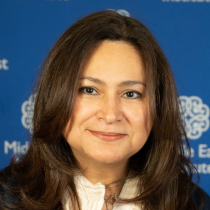
-
Egypt rejected Donald Trump’s idea to resettle Gaza’s population, but its own counterproposal for rebuilding the strip was rebuffed by the United States because it did not include a plan for disarming Hamas.
-
While Trump is in the Gulf on his first state visit of this term, the Egyptian government will be keeping a watchful eye on the proceedings.
For Egypt, life since President Donald Trump was inaugurated has been a little like a roller coaster ride after a heavy meal.
It started off well enough. Before he had even walked into the White House, President Trump took a decisively positive step in perhaps the most threatening of the conflicts on Egypt’s borders: the one in Gaza. Trump clinched a cease-fire, bringing temporary relief to Gaza’s besieged population. As a result of that agreement, the Houthis informed shipping companies that they would limit their attacks in the Red Sea to only Israeli ships. Considering those attacks had cut deeply into Egypt’s revenues from the Suez Canal, costing the country over $8 billion to date, the relief in Cairo was palpable.
And then, in late February, President Trump dropped a bombshell — the United States, he said, would “own” Gaza, and turn it into the “Riviera of the Middle East […] for the world’s people to live.” The world’s people, however, did not include Palestinians, whom Trump said would not be allowed to return and should be taken in by Egypt and Jordan. Cue the rollercoaster drop.
Egypt and Jordan both immediately rejected the idea, along with most of the rest of the world. Experts deemed it illegal and tantamount “to ethnic cleansing.” There followed an oscillation of announcements from the US president, which included veiled and not so veiled threats to slash funding to both countries, not appearing to take note of the fact that neither country could take in the Palestinians for a host of critical domestic reasons.
Considering the veritable ambush Jordan’s King Abdullah faced when he arrived at the White House and had to sit through a press briefing where Trump outlined his plans for the besieged enclave and its residents, Egyptian President Abdel Fattah el-Sisi has not taken President Trump up on his offer of a visit to Washington. Instead, Egypt scrambled to put together a plan to reconstruct Gaza without moving its residents. The plan was hugely detailed despite a glaring flaw — the lack of a mechanism to disarm Hamas. It obtained backing from Arab and Islamic countries as well as much of the rest of the world but was rejected by Israel and the US. Trump’s special envoy, Steve Witkoff, later conceded it was a “good faith first move.”
The next month brought relatively good news. In the tsunami of rising tariffs levied by Trump, Egypt got off relatively easily — the 10% tariff it faced was among the lowest meted out — potentially giving it an exporting edge. The business community’s joy, however, was short-lived, since Trump paused all tariffs, except for those on China, for 90 days, and their future remains hazy.
More bad news followed: Egypt’s Gaza plan appears to have been shelved due to Israeli Prime Minister Benjamin Netanyahu’s recent announcement of a de facto occupation of Gaza while pushing the remaining Palestinian population into a tiny area in the demolished south, aggravating domestic tensions in Egypt. Egyptians have a huge amount of empathy for the Palestinians, and the perception that Cairo is unable to help, actively hindered by Washington, is a potential security trigger within Egyptian society.
Finally, while Trump is in the Gulf on his first state visit of this term, the Egyptian government will be keeping a watchful eye on the proceedings. The president’s agenda will almost certainly include a potential US military base in the Red Sea, possibly on Tiran and Sanafir, two islands that Egypt transferred ownership of to Saudi Arabia almost a decade ago but has not yet vacated. A US base there would be desirable for Saudi Arabia but most certainly not so for Egypt. Such a military base would impinge on Egypt’s security, remove a military advantage, and potentially create more military cooperation between Saudi Arabia, the US, and Israel, while sidelining Egypt.
The challenge for Cairo, as for so many others, is to balance giving the transactional US president something he wants, while ensuring that it is a transaction one can afford.
Follow: @mmabrouk
US has fallen behind the region when it comes to seizing the opportunity in post-Assad Syria
Charles Lister
Senior Fellow, Syria Initiative

-
The Middle East has mobilized collectively to bring Syria in from the cold, while Europe and Canda have lifted and eased sanctions.
-
But while international engagement does count for something, Syria’s transition has little hope of stabilizing as long as US sanctions remain in place.
The first 100 days of the Trump administration have been an extraordinarily busy time for a Syria in transition — but not due to anything the United States government has done. In fact, since Donald Trump became president, most aspects of US policy on Syria have been frozen. While Syria policy had hardly been dynamic or proactive for many years, the fall of Bashar al-Assad’s regime in December 2024 presents a once-in-a-half-century opportunity to reshape the heart of the Middle East. However, this demands swift action, flexible thinking, and strategic vision.
In its final weeks in office, the outgoing Biden administration moved quickly to adapt to a post-Assad Syria: dispatching officials to Damascus to meet the transitional government at high levels; issuing a General License to temporarily ease sanctions; and engaging allies and partners around the world on questions of Syria’s future. In doing so, the Biden administration was acting in sync with the region, which also saw a chance to support and shape a transition that would allow Syria to reintegrate itself into the international system, foster long-term stability, and consolidate strategic defeats dealt to Iran and its partners since Oct. 7, 2023.
In contrast, the Trump administration, by keeping a distance from Syria — driven by a deep skepticism of the role being played by Islamist President Ahmed al-Sharaa and the remnants of his Hayat Tahrir al-Sham movement — has fallen far behind wider regional and international policy. The Middle East has mobilized collectively to bring Syria in from the cold. Already this year, President Sharaa and his Foreign Minister Asaad al-Shaybani have been on state visits to Qatar, Saudi Arabia, the United Arab Emirates, Turkey, and Jordan. Beyond the region, the European Union, United Kingdom, Canada, and Switzerland have all substantially lifted and eased sanctions; and Sharaa visited Paris on May 7.
But while international engagement does count for something, Syria’s transition has little hope of stabilizing while the vice-like grip of US sanctions continues to hinder reconstruction and economic recovery. The Trump administration has conveyed a set of conditions to Damascus, all of which have either already been met or are currently in process. When President Trump visits the region, his hosts in Qatar, Saudi Arabia, and the UAE will all push him to view Syria as an opportunity rather than a threat. Turkish President Recep Tayyip Erdoğan conveyed to same message to Trump in their phone call on May 5. Efforts are also underway to engineer a meeting between Sharaa and Trump during his time in Saudi Arabia.
In Syria, the clock is ticking. The country faces profound security, economic, social, and political challenges after 14 years of crippling conflict and more than 50 years of brutal Assad family rule. Syria would look chaotic and unstable no matter who was managing the transition — but attention must be fixed on the horizon. To realize the long-term goal of peace and regional integration, Trump does not need to spend vast sums of money, deploy military forces, or expend already stretched diplomatic resources. The region and Europe stand ready to play those roles. As one prominent regional diplomat told me recently, “The US just needs to get out of the way.”
Follow: @Charles_Lister
Ankara continues to see Trump’s return as an opening
Gönül Tol
Senior Fellow

-
For the first time in over a decade, Ankara sees a real chance to reset its frayed relationship with Washington.
-
The biggest opportunity to resolve long-lasting problems lie in post-Assad Syria.
For the first time in over a decade, Ankara sees a real chance to reset its frayed relationship with Washington. The surprising catalyst has been Donald Trump.
Over the previous 15 years, tensions over Iran, Syria, Russia, and China pushed the United States and Turkey from strategic alignment to mutual mistrust. Sanctions disputes, diverging war strategies, and Ankara’s deepening ties with Moscow and Beijing all eroded mutual confidence.
The breaking point came in Syria in 2014. To fight the Islamic State (ISIS), the US armed Syrian Kurds — groups Ankara sees as affiliates of the Kurdistan Workers’ Party (PKK), designated by both Turkey and the United States as terrorists — while Turkey stalled on granting American forces access to İncirlik Airbase. The fallout was swift. Tensions escalated further when Ankara bought Russian S-400 air-defense missile systems after years of bilateral haggling over the sale of US-made Patriots, triggering Turkey’s inclusion in the Countering America’s Adversaries Through Sanctions Act (CAATSA) and its removal from the F-35 program. Turkey’s early support for Ukraine, following Russia’s full-scale invasion in February 2022, did little to ease US concerns as Ankara deepened its energy ties with Moscow and refused to join Western sanctions. At the same time, billion-dollar Turkish electric vehicle (EV) and telecom deals with China only amplified Washington’s anxiety.
When Trump returned to the White House, Turkish officials braced for more trouble. But just months in, Ankara sees him as its best chance in years to reset bilateral relations with Washington.
First came reports that Trump rejected Israeli pressure to strike Iran — music to Ankara’s ears. Turkish officials see echoes of the 2015 Joint Comprehensive Plan of Action (JCPOA) — the nuclear deal struck with Tehran by former US President Barack Obama — in Trump’s preferred approach. And Ankara believes a possible breakthrough could ease sanctions and revive trade with Tehran.
Second, Trump’s apparent openness to cooperation with Russia, including apparently over Nord Stream Two — the inoperative natural gas pipeline that stretches from the Russian coast, under the Baltic Sea, to Germany, which the first Trump administration actively criticized and sought to prevent — has calmed fears in the Turkish capital. It suggests that US pressure on Turkey’s booming trade with Russia may also ease. Turkish officials also believe Trump could, therefore, revisit the S-400 standoff, clearing the path for renewed defense ties with the US.
Third, Ankara notes a shift in the White House’s tone toward China. Despite tariffs, Trump’s sidelining of hardline China hawks suggests to Turkish officials that their economic engagement with Beijing may not draw the same backlash it had under Biden.
Under Trump’s sweeping 2025 tariff regime, Turkey was subjected to a baseline 10% tariff on exports to the US, significantly lower than the 20-25% rates imposed on major trading partners like China, the European Union, and Japan. Although these tariffs have dealt some blows to Turkish exporters, Ankara has largely weathered the storm thanks to diversified trade ties and its emerging global role as a supply-chain hub — particularly in renewable energy.
But the biggest opportunity may lie in post-Assad Syria. Ankara is pitching Trump a new formula: let Turkey lead the fight against ISIS while allowing Syrian Kurdish forces to be folded into a unified national military. At the same time, it seeks to reassure Washington that Iranian influence in Syria is shrinking. The situation since Bashar al-Assad’s fall may offer Ankara a golden chance to defuse one of the most toxic issues in US-Turkey ties: the S-400s. Turkish officials are reportedly weighing the option of relocating the Russian missile systems to a Syrian base Turkey aims to control. Ankara is likely betting that moving the S-400s off Turkish soil could give Trump political cover to lift CAATSA sanctions and reopen the door to the F-35 program. In Ankara’s view, no other file holds more potential for resetting the relationship than Syria.
Still, risks abound. A US strike on Iran could drag Turkey into a regional crisis. A misstep in Syria might provoke a clash with Israel. And if Trump reverts to hard sanctions on Russian energy, Turkey’s fragile economy could take a serious hit.
But for now, Ankara sees an opening — and in Trump, a dealmaker it thinks it can work with. After years of divergence, the door to a reset is ajar. Turkey is ready to walk through it.
Follow: @gonultol
How US-Gulf coordination can secure Lebanon and reshape the Levant’s future
Fadi Nicholas Nassar
Senior Fellow
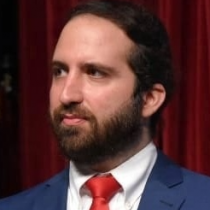
-
With determined US backing, the Gulf states can help generate the political momentum for new leadership in Lebanon and Syria to take the risks they need to put their country on a path toward functional, sovereign governance.
-
Right now, nowhere is that possibility more tangible than in Lebanon, where a serious, strategic push to empower the Lebanese state could catalyze the country’s transformation and support Syria’s road to recovery.
President Donald Trump’s first visit to the Middle East in his second term is no diplomatic stopover, it is a strategic inflection point that can lay the foundation for securing a stable regional order. The region President Trump returns to is not the one he left. The Gulf states, once viewed through the prism of resource wealth and security dependence, are now asserting themselves as architects of the future. From strategic investments in emerging technologies to mediation on the global stage, the Gulf’s new posture paves the way for reimagining US-Gulf relations, moving beyond the oil-for-security framework of the past and toward a new, long-term regional architecture.
Meanwhile, on the Eastern Mediterranean, the Levant stands at a crossroads of its own. Hassan Nasrallah and Bashar al-Assad, once towering pillars that heralded the inevitable ascent of Iranian hegemony, are gone. But the legacy of that Iranian project — failed states, battered economies, and populations shackled by war and crisis — has not fully gone with them. Syria and Lebanon remain suspended in dysfunction.
At first glance, the trajectories of the two could not seem more different: one aspiring to engineer the future, the other surviving the past. Yet their paths, like the region they share, remain deeply interconnected. The lesson from Russia’s invasion of Ukraine is clear: When a neighborhood is left vulnerable, rivals set their terms. The catastrophic events that followed Oct. 7, 2023, delivered a similar warning closer to home: instability in the Levant cannot be contained and threatens the wider region’s forward momentum. It is in that shared future where the opportunity and urgency lie.
With determined US backing, the Gulf’s rising influence can do more than project power or bankroll recovery; it can help generate the political momentum for new leadership in Lebanon and Syria to take the risks they need to put their countries on a path toward functional, sovereign governance. And right now, nowhere is that possibility more tangible than in Lebanon. Ironically, it is Lebanon’s small size that makes it both vulnerable and winnable. Hezbollah has been decimated, Iran’s narrative has lost its currency, and the broader public is exhausted by endless wars and crises. These critical setbacks have been met with a new head of government and state in Beirut outside Hezbollah’s sphere of influence. A serious, strategic push to empower the Lebanese state — before that narrow window for action closes — could catalyze Lebanon’s transformation and support Syria’s road to recovery. If this opportunity is missed though, it risks giving time and space for spoilers to derail the region’s progress and once again threaten a renewed cycle of conflict and instability.
But it is the Lebanese who must make the historic decision to either preserve a familiar status quo or decisively break from the past and turn the Lebanese state in a reliable partner in a new regional order.
This is where coordinated US-Gulf leadership is indispensable.
The United States, a critical supporter of the Lebanese Armed Forces (LAF) and the only actor capable of leveraging influence with Israel, is uniquely positioned to maintain steady focus on all parties to ensure the full implementation of the November 2024 cease-fire deal that ended more than a year of fighting between Israel and Hezbollah. Meanwhile, its Gulf partners are Lebanon’s last economic lifeline and can condition their support on clear strides to establish a sovereign state that investors, international partners, and its people trust.
More than anything, Washington and Riyadh must speak with one voice: Hezbollah’s disarmament is not a matter of negotiation — it is already agreed upon. Its full disarmament is the prerequisite for Lebanon to return to the regional fold and the Lebanese state to reclaim its legitimacy. And this message must be clear not only to the cautious leadership in Beirut, but to the perennial spoiler in Tehran.
That means the Lebanese government must take demonstrable steps — by the end of this year — to follow through with the disarmament of Hezbollah. Official rhetoric from the president and prime minister that affirms the Lebanese state’s monopoly on force is a promising start. But it is undermined when Hezbollah representatives continue to defy it.
The cease-fire agreement that ended the war must be framed correctly: not as a de-escalation of the conflict, but as a short timeframe to allow the Lebanese state to peacefully complete the process of Hezbollah’s disarmament and avoid another military confrontation.
The Lebanese state must lead, and it must be steadily backed by its partners. The active efforts of the LAF and the Lebanese state to demilitarize extensive parts of southern Lebanon and control strategic ports further demonstrate the will and capacity of the Lebanese to meet the momentous task still at hand. And while the US and Gulf partners can offer the necessary financial and logistical support, they can also telegraph to Iran that further obstructionism will not salvage Hezbollah. A military solution is already unfolding, with Israel as the de facto enforcer.
Lebanon can transform from the strategic hub of the Axis of Resistance that destabilized the region into a trusted partner committed to maintaining regional stability. But that transition requires tough, sovereign decisions only the Lebanese can make. The role of the United States and Gulf partners is not to dictate those choices but to enable them: by anchoring support to clear conditions, aligning incentives with reform, and tying Lebanon’s recovery to a wider regional project defined by economic progress, stability, and good governance. The window for action is closing, but with deliberate coordination and political will, it is still within reach.
Follow: @dr_nickfn
Trump’s footprint in North Africa: Transactional diplomacy or enduring impact?
Intissar Fakir
Senior Fellow
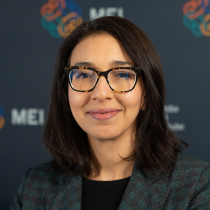
-
North Africa’s deepening ties to the Gulf states, expanding role in energy markets, and growing significance for regional security and counterterrorism make it key to any serious Middle East strategy.
-
Whether competing with China, advancing the Abraham Accords, securing critical resources, or managing migration, the region is central to US strategic interests.
In his first term, President Donald Trump reshaped North Africa’s political landscape more dramatically than any recent US administration. His recognition of Moroccan sovereignty over Western Sahara — reversing decades of US policy and part of a broader deal that normalized Israeli-Moroccan relations — marked a breakthrough in transactional diplomacy. This was not peripheral policymaking; it was a strategic realignment with lasting consequences. In the first 100 days of his second term, however, the Trump administration has yet to show much interest in the region.
As Trump prepares for his trip to Saudi Arabia, Qatar, and the United Arab Emirates, North Africa’s relevance becomes even clearer. The region’s deepening ties to the Gulf states, expanding role in energy markets, and growing significance for regional security and counterterrorism make it central to any serious Middle East strategy. Saudi and Emirati investments are transforming Morocco’s infrastructure and energy sectors. The UAE’s military presence in Libya shapes Mediterranean security. These Gulf-North Africa linkages form a web of interests Washington cannot afford to ignore.
The Abraham Accords further underscore this interconnectedness. Morocco’s normalization with Israel in December 2020 opened North Africa to new diplomatic and economic opportunities. Morocco may also prove valuable as a connector to the Sahel — not only for regional security coordination but also to facilitate US access to critical minerals. Buoyed by US support on Western Sahara, Morocco is courting investment — including from the US — for its Atlantic Initiative, aimed at linking Sahelian states to global markets via Moroccan ports.
China’s expanding presence in North Africa adds urgency to US engagement. Beijing is building ports in Algeria and Mauritania, investing heavily in Morocco’s tech sector, and positioning itself as a partner for reconstruction in Libya. These are not just economic moves — they are strategic footholds challenging US and European influence across the Mediterranean.
Energy security is another key factor. Algeria’s natural gas remains vital to Europe’s energy diversification strategy — a US strategic priority even as it ramps up its own liquefied natural gas exports. Libya’s oil reserves, the largest in Africa, continue to influence Mediterranean stability. Morocco’s leadership in renewable energy presents opportunities for US clean tech partnerships and climate diplomacy. And Morocco’s control of roughly 75% of global phosphate reserves, a key input in fertilizer production, could have implications for US agriculture.
Migration, a persistent Trump-era concern, runs through North Africa. Tunisia, Morocco, and Libya serve as both transit hubs and policy partners. The Trump administration is reportedly planning to deport migrants to Libya, reflecting a strategy like certain EU policies, although Libyan authorities denied it and a US judge subsequently blocked the move. Cooperation — or lack thereof — on migration directly affects European stability and, by extension, US relations with its key allies.
Security and counterterrorism cooperation have long anchored US engagement in the region. Morocco and other North African states remain critical partners in efforts to counter transnational threats, contain instability in the Sahel, and prevent the resurgence of violent extremism.
As Trump’s team shapes its foreign policy agenda, one thing is clear: North Africa is not adjacent to Middle East strategy, it is integral to it. His administration’s own legacy in the region offers a foundation for renewed engagement. Whether competing with China, advancing the Abraham Accords, securing critical resources, or managing migration, North Africa remains central to US strategic interests.
To overlook it would be to cede ground to adversaries who already recognize what Washington risks forgetting: In today’s interconnected world, North Africa is where European, Middle Eastern, and African interests converge — and that makes it a region no US administration can afford to ignore.
Follow: @IntissarFakir
In Libya, a US reset amid regional realignments
Jonathan M. Winer
Distinguished Diplomatic Fellow
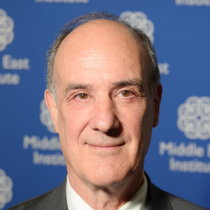
-
On the eve of President Donald Trump’s visit to the Middle East, the framework of a US policy approach to Libya is beginning to emerge, but it lacks full coherence and a clear political strategy.
-
At issue are engagement with various actors to the conflict, Russia’s presence in the country, and the level of support for governance reforms.
After years of drift during President Donald Trump’s first administration, a more deliberate US policy toward Libya has begun to take shape in the early months of the second. Recent visits by the commander of the US Sixth Fleet, Vice Admiral J.T. Anderson, Special Envoy Richard Norland, and Chargé d’Affaires Jeremy Berndt reflect a coordinated re-engagement strategy, with meetings held across Libya’s fractured political landscape.
Following a stop in Tunisia, the USS Mount Whitney made high-profile port calls in both Tripoli and Benghazi on April 21-22. The US described the mission by the flagship of the US Sixth Fleet as advancing “regional stability, national unity, and Libyan sovereignty,” while underscoring the goal of revitalized US-Libyan military cooperation.
Beneath the diplomatic framing lies a more strategic imperative: countering Russia’s entrenched military presence in Libya, particularly in the east. With major Russian assets based and actively operating in territory controlled by Gen. Khalifa Hifter, commander of the Tobruk-based Libyan National Army, Washington appears to have decided that any meaningful effort to diminish Moscow’s influence requires dialogue with Hifter and his inner circle. In recent weeks, this decision has included undertaking intentionally visible meetings with his politically ambitious sons, in Washington as well as in Libya.
This pragmatic calculus is not without risks but echoes key conclusions from a May 2024 North Atlantic Treaty Organization (NATO) policy paper co-authored by Norland and other senior analysts. The paper argues that in fragile or divided states, engagement with “non-accountable” actors may be a necessary — if uncomfortable — tool for advancing broader security objectives. Right or wrong, the newly inclusive US policy shepherded by Amb. Norland reflects his final acts in making and implementing Libya policy. After nearly six years as first ambassador and then special envoy, Norland announced his resignation from the position, and the State Department, effective at the end of May. Two days later, White House officials stated they would be immediately sending deportees to Libya by military aircraft to be held in the country’s notoriously brutal detention centers, prompting a US judicial ruling to stop the operation, along with professions of outrage and opposition to the plan by senior Libyan officials in both Tripoli and Benghazi.
The US moves come amid shifting regional alignments and broader recognition of the Hifter factor across Libya’s political spectrum. Egypt, a long-time supporter of the general, is seeking to leverage Trump’s visit to the region to reinforce its strategic weight in eastern Libya, particularly on security coordination and energy corridor access. Meanwhile, Turkey has stepped up its engagement with Libyan actors on both sides of its political divide, entering into new agreements with Abdul Hamid Dbeibah’s Government of National Unity while courting the Hifter family, as reflected in meetings in April with Saddam Hifter in Ankara and with other Hifter military officials in Benghazi to discuss military cooperation.
Beyond countering Russian encroachment, the US also seeks to prevent Libya from becoming a platform for transnational terrorism or an ungoverned zone of instability spilling into the Sahel, threatening Mediterranean maritime routes, or disrupting Europe’s southern border. On those issues, it should seek common cause with both Egypt and Turkey, despite their own delicate dance with Russia.
While a framework has begun to emerge, US policy toward Libya remains incomplete, and as reflected in the aborted Libyan deportation plan, functionally incoherent. Tactical engagement with security actors has yet to be matched by a clear political strategy to support more effectively the UN’s continuing but long-stalled efforts to bring about inclusive governance, constitutional reform, and credible elections. Absent such a foundation, Washington’s re-engagement risks reinforcing the very fragmentation it hopes to resolve. At stake is more than Libya’s fate: It is whether the US and whomever may succeed Amb. Norland can still shape outcomes in a region increasingly claimed by others.
Follow: @JonathanMaWiner
Afghanistan and Pakistan have commanded little time and interest from Washington. Could that now change?
Marvin G. Weinbaum
Senior Fellow

-
The Trump administration has withdrawn funding for critical humanitarian assistance programs in Afghanistan and reaffirmed it will not restore a diplomatic presence in Kabul, even as it looks to the Taliban regime to cooperate with plans to repatriate thousands of Afghan refugees stripped of their protected status.
-
The US is pressing Pakistan to make economic concessions, loosen ties with China, and crack down on militants; the recent outbreak of hostilities with India has now provided President Donald Trump an opportunity to play the coveted role of “peace maker.”
When President Donald Trump visits Saudi Arabia, Qatar, and the United Arab Emirates this week, he will be on the doorstep of Afghanistan and Pakistan, two countries whose region had once drawn great attention from the United States but more recently has commanded little time and interest. Even so, they, like much of the international community, have not escaped the headwinds of an administration in Washington that above all treats countries by how they are seen as contributing to “making America great again.” By that measure, Afghanistan and Pakistan have been failing to meet expectations.
Afghanistan’s Taliban government has rebuffed Washington’s attempts to seek the return of the vast stores of equipment the US military left behind when it hastily pulled out in August 2021 and to give the US access to the once vital Bagram Air Base. Kabul has ignored efforts to coordinate intelligence sharing and done little to stymie the activities of various terrorist organizations operating from their Afghan redoubts. The Trump administration’s decision to withdraw funding for critical humanitarian assistance programs that have indirectly served to stabilize the Afghan economy has driven the countries even further apart. Washington recently reaffirmed its intention not to restore a diplomatic presence in Kabul. Yet the Taliban regime will shortly be expected to cooperate with the Trump administration’s plans to repatriate thousands of Afghan refugees stripped of their protected status.
An economically hard-pressed Pakistan is being tested on its willingness to make deep tariff and non-tariff concessions, allegedly having “ripped off” the US. The Trump administration would also like to see Islamabad put more military muscle into rooting out militant Islamic terrorist organizations like al-Qaeda and Islamic State-Khorasan Province. Finally, Pakistan is expected to demonstrate its worth by moving toward loosening its strong economic ties with China and by agreeing to a deal to give the US access to its rare mineral deposits.
Pakistan and Afghanistan had openly welcomed the Trump administration. Both had found much to be displeased about with President Joe Biden’s policies. They reasoned that the new administration might be open to taking a fresh look at relations or, as Kabul put it, “begin a new chapter.” The Taliban could recall that in its encounter with the first Trump administration, it scored a “sweetheart deal” in the Doha agreement that paved the way for a US troop departure. Pakistan never got over what it saw as Biden’s lack of respect for the country and its leadership nor his tilting of American foreign policy in favor of India. The US was also bitterly accused by many of interference in Pakistan’s domestic politics, contributing to the ousting of Imran Khan as prime minister in April 2022. President Trump’s joint address to Congress in early March, where he singled out Pakistan for praise for assisting with the arrest of a notorious terrorist, seemed to herald a new and more positive relationship with Washington. Of course, the optimism of both Pakistan and Afghanistan has not been borne out by events.
The crisis over Kashmir thrusts Pakistan onto the international stage, casting it once more as a consequential state actor for the US. Washington’s willingness to help avoid all-out war between India and Pakistan has afforded President Trump a much-coveted opportunity to play “peace maker,” a role that has so far eluded him in Gaza and Ukraine. That this US engagement diplomatically presages closer involvement with the region cannot be assumed. But it does underscore that the US, despite its diminished international profile, remains the country of choice for mediating the world’s most perilous inter-state conflicts.
Follow: @mgweinbaum
Trump’s first visit abroad is to a region increasingly dominated by great power competition
Iulia-Sabina Joja
Senior Fellow

-
Even though the second Trump administration is currently keen to downplay great power competition in favor of striking deals, the reality of the shifts reordering the Middle East might be an obstacle to such a policy rethink.
-
The Gulf states are engaging in a strategy of diversifying their alliances and reducing their reliance on the US, seeking to balance their relations with an increasing number of global poles, including China and Russia.
The competition among global powers in the Gulf is all about business — in energy, of course, but advanced technology plays an increasingly central role too. And the United States remains a key player in this ever more crowded field of contenders. US President Donald Trump’s first administration notably emphasized the concept of great power competition, which shaped Washington’s foreign policy approach across all regions around the world, including in the Middle East. There and elsewhere, the US actively pushed back against primarily China, but also Russia and Iran. Yet more than 100 days into the second Trump administration, US foreign policy priorities seem to be shaping up very differently. Pushback against rival powers has been replaced by the White House’s desire for major business deals. President Trump’s first planned visit abroad, to the Gulf, very much reflects this change in emphasis, where he will seek to showcase the tangible benefits of his “America First” foreign policy. Yet no matter what business deals are struck with the host governments, the US will continue to have to navigate the increasingly complex great power competition in the Middle East region.
Trump’s trip to Saudi Arabia, Qatar, and the United Arab Emirates this week takes place under considerable pressure. The Gulf remains central for global energy flows, but the Tehran-backed Houthis’ campaign of attacks on maritime trade in the Red Sea has been a major disruptor and raised fears that Iran — either itself or through its regional proxies — may seek to escalate or raise the pressure on its adversaries by similarly trying to shut down the Strait of Hormuz. More than one-fifth of global oil is transported via this strategic chokepoint. One of the US’s traditional priorities in the Middle East has long been preserving freedom of navigation and regional stability; but its bombing campaign to deter and, if possible, neutralize the Houthis, begun under President Joe Biden and temporarily expanded under Trump, brought mixed results.
Even though the Trump administration is currently keen to downplay great power competition in favor of striking deals, the reality of the shifts reordering the Middle East might be an obstacle to such a policy rethink. In recent years, all three of America’s competitors have improved their strategic foothold in and around the Arabian Peninsula, at the expense of US national interests and regional influence. In March 2025, Iran, Russia, and China held their fifth yearly naval drills in the Gulf of Oman. Moreover, Iran has improved its relations with all three Arab Gulf states where Trump will make a stop this week — Qatar, the UAE, and Saudi Arabia. Qatar and Iran have held a number of high-level meetings in recent years and signed several security and economic agreements, including the creation of a joint security and police committee. In 2023, Iran and the UAE held their first joint economic commission meeting in 10 years and boosted cooperation in energy, trade, and infrastructure development. The same year marked a historic thaw between Saudi Arabia and Iran: The two countries reestablished diplomatic ties, facilitated by Beijing. The Yemeni Houthis, which have shown the capacity to jeopardize global trade flows around the Arabian Peninsula and to put regional stability at risk, are today one of Iran’s most important non-state allies and receive additional support from Russia.
Its strategic defeat in Syria following the collapse of Bashar al-Assad’s regime notwithstanding, Moscow too has made strides in the Gulf under the banner of strategic competition. The Gulf states have opted not to impose sanctions on Russia following the latter’s full-scale invasion of Ukraine. In July 2022, then-President Biden visited Riyadh in part to push the Saudis to raise the Organization of the Petroleum Exporting Countries’ (OPEC) production quotas in order to reduce Russian oil revenues and undermine Moscow’s ability to finance its war machine; that effort proved unsuccessful. The Kremlin has continued to intensely court the Gulf with offers of weapons sales, although Russian arms exports have dramatically declined over the past three years. In 2024, the US and European allies pressured the UAE to curtail its role in enabling Russian sanctions evasion — with modest results. China is today the largest importer of Gulf oil and the region’s biggest trading partner. Beijing’s tech giants such as Huawei and Alibaba Cloud have also partnered up with the UAE, Saudi Arabia, and Qatar in artificial intelligence (AI) and developing critical infrastructure for massive projects, including smart cities, digital infrastructure, photovoltaic energy storage, video surveillance systems, and cybersecurity.
The Gulf states are engaging in a strategy of diversifying their alliances and reducing their reliance on the US. They have managed to effectively navigate the international context of great power competition, successfully balancing among a growing number of global poles. For Washington, however, this has meant increased difficulty in preserving its standing within this gradually more competitive environment in the Middle East. Trump’s visit will be a litmus test of America’s capacity to reassert its once nearly unchallenged influence.
Follow: @IuliJo
The Middle East Institute (MEI) is an independent, non-partisan, non-for-profit, educational organization. It does not engage in advocacy and its scholars’ opinions are their own. MEI welcomes financial donations, but retains sole editorial control over its work and its publications reflect only the authors’ views. For a listing of MEI donors, please click here.






